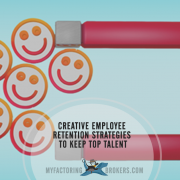New data suggests that stress among workers is on the rise despite the improving economy, and stress is the third most common reason cited by departing employees. Remedy these nine workplace employee stress points, boost retention and make your organization an awesome place to work.
Be Awesome… Eliminate Employee Stress Points that Cause Employees to Quit
Employee stress – cited as one of the most common reasons employees said they left an employer – is on the rise among US workers, with women suffering more from workplace stress than their male counterparts, according to a new survey from Randstrad Engagement. Here are nine ways to reduce employee stress and make your business more awesome in the process.
We share dozens of news stories on our social networks each week that we believe could be of interest to our audience; most of them related to ways to grow or improve a business. When it comes to news stories related to the economy, we usually try to find stories with a positive bent. In other words, to provide business advice that comes along with helpful things to-do rather than a list of negative not-to-do’s.
We came across a list of nine factors related to employee stress on benefitspro.com. While it touched on the negatives, it didn’t address the positive, so rather than share it as a link we thought it made more sense to give you our own take on it, instead.

9 Ways to Address Employee Stress Factors that Might Make Employees Leave
1. Low Pay
One obvious way to address this stress factor is to raise wages; however, that is not always possible and may not even be appropriate. If you feel that you are paying competitive wages already, it might be necessary to change perceptions by demonstrating that positions are being compensated fairly for the market and corporate role, or to better communicate to employees the whole wage and benefit package they are receiving.
Money isn’t everything! Employees focused solely on their hourly wage or salary may not be factoring in benefits, perks, organizational culture or privileges they enjoy that are unique to your business. Consider generating a once-yearly letter or report for each individual that communicates the amount of money the organization is also investing in paid time off, conferences and education, various insurance benefits, employee discounts, retirement, pension, 401k or other investment programs.
2. Bad Commute
You may not be able to move your organization’s physical location closer to employees homes, but you may be able to offer flexibility in working hours that mean employees don’t have to be on the road during peak commute times or reduce time spent on the road by allowing employees to work 4 ten hour days (in lieu of employees scheduled to work a traditional eight hour day, 5 days per week).
Other ways to potentially reduce employee commute time is to enable employees to work from home on an occasional or regular basis, providing a subsidy for employees opting for public transportation or raising an employee’s pay to help offset increased commute-related expenses.
3. Unreasonable Workload
There are many circumstances that can lead to one or more employees with an imbalanced work load. The departure or temporary absence of a team member, shuffling of responsibilities within the department or even simply being an over-achiever can put a staff member in a position leading towards burnout. Even in the absence of employee complaints, it is probably a good idea to review employee and department workload, performance and productivity against corporate goals with the view of determining if it’s time to consider adding to staff or re-balancing the workload among staff members.
4. Annoying Co-Workers
Chances are that if you add to your organization with a goal of supporting and enhancing the culture as much – or even more – than you do merely adding competencies, you are unlikely to lose good employees due to stress caused by annoying co-workers. If organizational culture has not been a priority within your business, there’s no time like the present to make it one!
Even given vast differences in personality and lifestyles, an organizational culture characterized by mutual respect and where employees have shared values when it comes to communication and other characteristics of interpersonal relationships is unlikely to have employees who are stressed out by one another.
If you have warring co-workers or employees who are unhappy with one another, consider investing in team building and educational training where communication skills can be improved and participants are encouraged to think more empathetically toward individuals with personality traits that are different from their own.
5. Poor Work-Life Balance
Even business owners need to strike a healthy work-life balance. Be sure that your employees know that you value them as individuals, not just wheels in the corporate cog! Consider whether you can enhance employee benefits by providing, subsidizing or even simply facilitating (through flexible work schedules) employees’ participation in local gyms, recreation centers, dance or hobby classes, etc.
6. Work Outside of One’s Chosen Career, Interest
Finding ways to mesh an employee’s individual career goals with their current role and potential for advancement in your organization can go a long way to helping you keep employees you value most, not to mention transforming them into loyal employees who have a vested interest in the success of your business!
7. Lack of Opportunity or Advancement
Make sure employees know how organizational growth will create opportunities for advancement. If these opportunities are unlikely to emerge, or are unlikely to emerge quickly enough, consider whether you can keep valuable employees longer by facilitating their professional development through education, training or mentoring. If employees want to move forward professionally but opportunities do not exist within your organization, help by networking them with peers, recruiters and other business owners.
8. Bad Boss
If this is you, you might not know it (or might not want to admit it). If this is a manager within your organization, you might not want to deal with it. However, every employee in your organization deserves to have qualified, competent, quality leadership. When poor leadership is knowingly kept in place, the organization is held back in some way. Making decisions that are in the best interest of the organization often requires dealing with unpleasant situations and having uncomfortable conversations. In the long run, it’s worth it!
9. Fear of Layoff or Termination
Fearful employees work differently than those who are confident of their role within and value to the organization. Establish a monthly or quarterly meeting or communique that lets employees know how the organization is doing in general and against its specific goals, what to expect in coming months and who to talk to if they have questions or concerns about the health of the business or their role in the organization.











Leave a Reply
Want to join the discussion?Feel free to contribute!